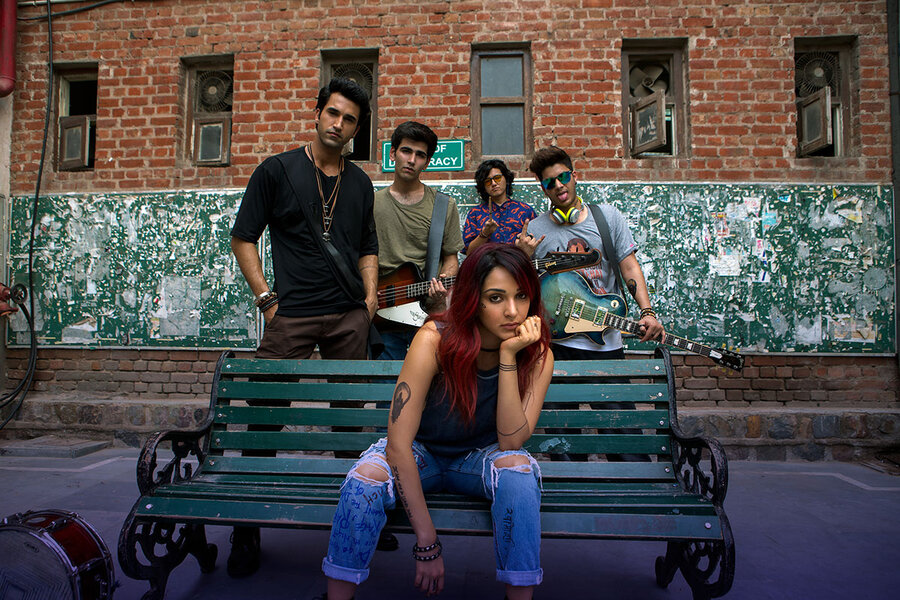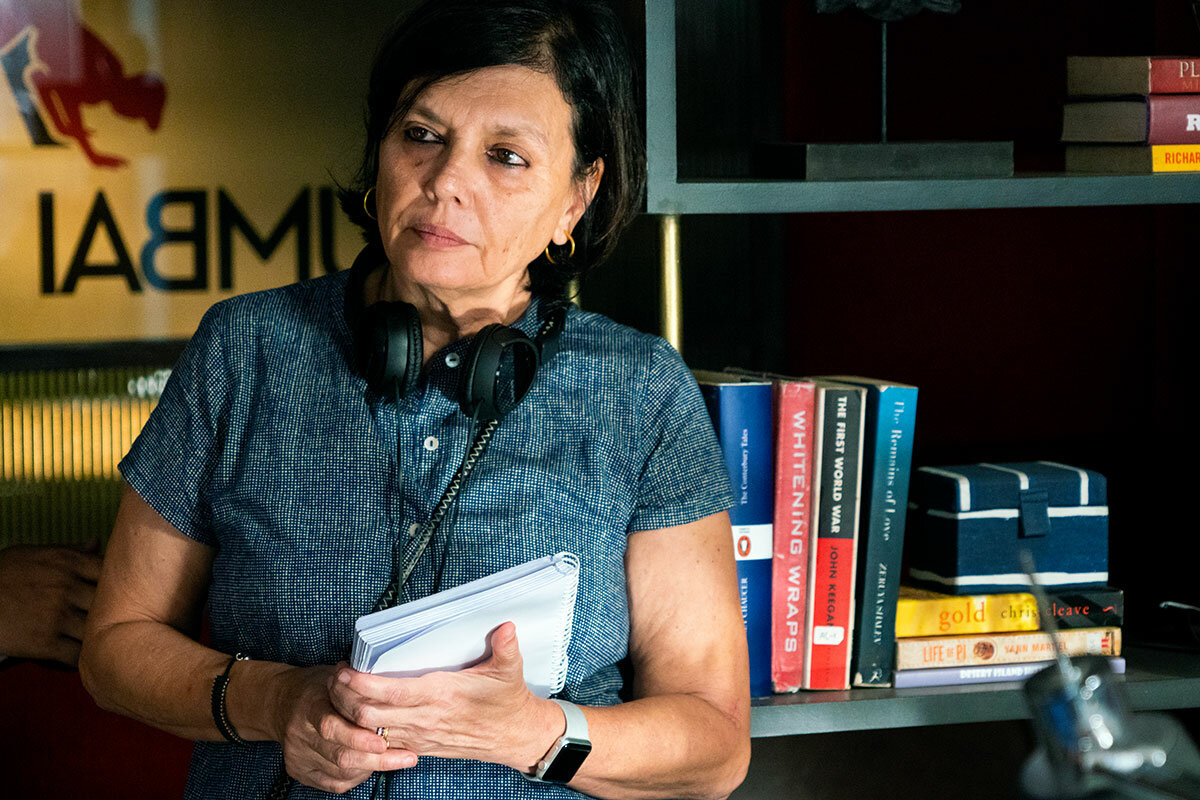Opportunity strikes: More women behind Bollywood’s cameras
Loading...
| Mumbai
“Guilty,” a Netflix original film, bears little resemblance to commercial Bollywood cinema. Set on an Indian college campus, it tackles the often-taboo topic of sexual assault. The cast boasts no major male stars, nor dance numbers. And unlike most theatrical releases, it was directed by a woman.
The film was released in March, and was frequently on Netflix India’s “Top 10” panel. But director Ruchi Narain, best known for writing a critically acclaimed drama in 2003, often faced a question: “Why has it taken you so long [between films]? Where did you go?”
“I’m like, nowhere!” she says, chuckling. “I was right here. I was flogging my scripts, meeting actors, doing everything any filmmaker does.”
Why We Wrote This
Streaming services have changed the game for film fans: Going to the movies means opening up your laptop on the couch. But they're changing what happens behind the camera too – especially for women.
For Ms. Narain, a streaming platform offered opportunities the rest of the film industry had not. In Bollywood, “money rides on male stars, and male stars have their own concerns. They may or may not want to take instructions from a woman, whether they say that or not,” she says.
Film industries in India – of which the Hindi-language Bollywood is the biggest – churn out more than 1,500 films a year. But Bollywood’s closed-in, clubby nature and risk aversion have historically sidelined women-led films, many industry experts say.
But here, as in other countries, that is changing. Platforms such as Netflix, Amazon Prime, Disney+ Hotstar, Voot, Zee5, and ALTBalaji are transforming the scope, scale, and variety of stories being told. A PWC India-Assocham report in 2018 estimated the industry would more than double in value from 2017 to 2022, reaching almost 54 billion rupees (then around $820 million). Liberated from the usual pressures of box office results, exhibition, and distribution, filmmakers in general are finding new opportunities in the digital space.
“The transition from single-screen theaters to multiplexes made a huge difference for women and the kinds of stories” that get told, says Ms. Narain. “Like that, the transition to digital is going to bring a sea change.”
Alankrita Shrivastava is one of the writers and directors behind Amazon’s acclaimed web series “Made in Heaven,” a drama about two wedding planners and their personal and professional lives. It was praised for its canny depiction of urban India, and its deft treatment of themes of sexuality, class, and marriage. She describes roadblocks in the industry as a complex set of interlocking factors. Women may be less interested in the hero-focused films favored by studios, for example; may not find recognizable actors to cast; and then struggle to market their films, affecting earnings. This leads to a cycle, reinforcing the notion that movies made by or led by women are less bankable.
“Definitely streaming platforms are more democratic. There’s more space for diverse voices and women,” says Ms. Shrivastava. “A lot of the network executives are women and open to different kinds of content.”
Streaming shift
There is no reliable national data on the proportion of Indian programming that is women-helmed, but the increase in the number of women behind the camera appears to line up with worldwide trends.
Across U.S. platforms, women jumped from 12% of directors in 2014-15 to 30% in 2019-20, according to the latest “Boxed In” study by Martha M. Lauzen, founder and executive director at the Center for the Study of Women in Television and Film at San Diego State University. When just streaming platforms were considered, the figure went from 10% in 2017-18 to 32% in 2019-20. This year, the study notes, streaming services “featured substantially more female protagonists” than cable or broadcast programs: 42%, 27%, and 24%, respectively.
“For film there can be only one director. For episodic [formats] you can have a female director for every episode,” says Madeline Di Nonno, chief executive officer of the Geena Davis Institute on Gender in Media. “So, with the proliferation of streaming platforms – Netflix, Amazon, Disney+, HBOMax, Peacock, Quibi – you have many more new and global distribution outlets that have to fill their pipeline with content.” However, she also points out that "Boxed In" found 76% of programs studied across platforms had no women directors, and 73% had no women creators.
Some platforms say they are actively committed to rectifying imbalances.
“We have always encouraged women, be it within the organization, in our shows, or behind the camera,” says Ekta Kapoor. As joint managing director of Balaji Telefilms, one of India’s biggest entertainment companies, and managing director of ALTBalaji, its streaming platform, Ms. Kapoor has often been described as one of the most powerful women in television. “As they say, content is reflective of the thought process of the creators; we at ALTBalaji have always strived to break the existing stereotypes.”
Among ALTBalaji’s most popular shows are two directed by women: “Mentalhood,” about multitasking mothers; and “Baarish,” a love story. One of Amazon Prime’s most talked about shows here is “Four More Shots Please” – often described as an Indian “Sex and the City” – and Netflix is this year working with 30 women producers and directors. In 2020, in addition to “Guilty,” the platform released Ms. Shrivastava’s film “Dolly Kitty Aur Woh Chamakte Sitare,” about two women cousins in North India finding themselves, and Sooni Taraporevala’s real life-inspired film about two Mumbai boys pursuing their ballet dancing dreams.
“If it had been financed by conventional producers for theatrical release, I would have got two rupees to make it,” says Ms. Taraporevala, of “Yeh Ballet.” “It’s gratifying for me as a filmmaker to be able to tell stories that are real, without stars, on niche subjects, get the budget the film needs, and have it be promoted well.”
More stories on screen
More women behind the camera also has a ripple effect for women in front of it. “We have found from our previous research that when there is a female writer-director it directly impacts the percentage of female characters on screen,” says Ms. Di Nonno, of the Geena Davis Institute. “Women are 51% of the population, and as such need to see their stories told authentically onscreen.”
Nor are the gains just for women. With digital services, every film or show does not need to cater to every viewer, opening up more opportunities for different stories. Audience diversification and fragmentation “means women get more opportunities because now you are telling all kinds of stories,” says Ruchi Joshi, who co-directed one web show and is in talks for another. “We are making shows for people across classes, across genders.”
As yet, India’s digital shows have been relatively untouched by censorship, allowing greater freedom in portraying women’s lives. Filmmakers and executives believe it has also allowed flawed and more complex women characters to take shape. “With more female creative helms – be it writers, directors, producers – comes more female characters, with more agency, better representation and more engaging plots and themes – something that has never been portrayed before,” says Aparna Purohit, head of India Originals at Amazon Prime Video.
With theaters shut until now, amid the pandemic, even more people have turned online for entertainment. Films meant for theatrical release have opted to go digital, including Ms. Shrivastava’s latest.
But she highlights the charm of watching big screen films, while warning against treating digital platforms as a panacea for gender gaps. “Just because streaming platforms are relatively more democratic shouldn’t be a reason to edge women out of the commercial theatrical space,” she says. “I think there should be equality in all mediums.”







